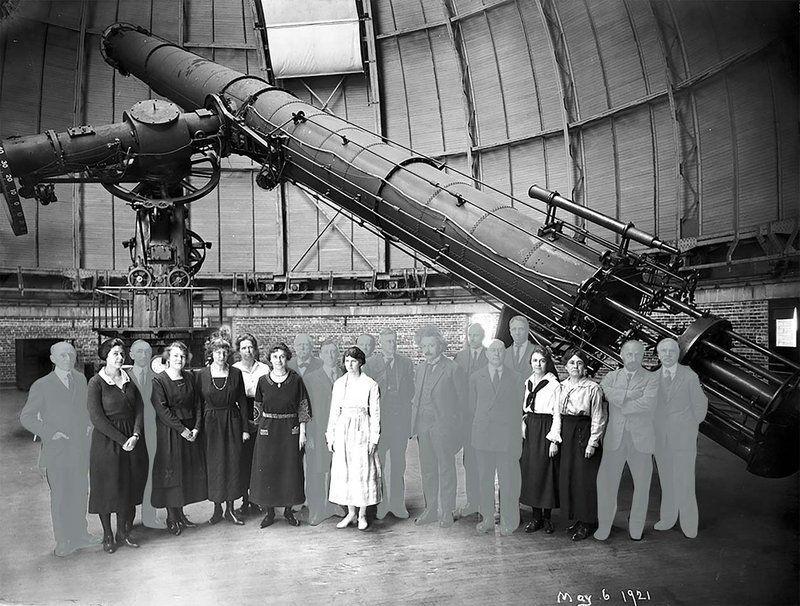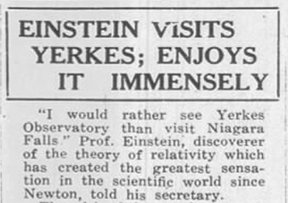Women at Yerkes

The staff of Yerkes Observatory and Albert Einstein, May 6, 1921. Then, as now, the Yerkes telescope was the largest refracting telescope ever build for astronomical research.
“I would rather see Yerkes Observatory than visit Niagara Falls."

When Albert Einstein visited Yerkes Observatory in 1921, it was front page news of The Lake Geneva News. “I would rather see Yerkes Observatory than visit Niagara Falls,” Einstein told his secretary, and he stated, “that his day at Yerkes was the most pleasant that he had spent in America.”
As one of the world’s most famous physicists, Einstein was welcomed warmly by Edwin Frost, the Observatory’s director, and his staff, who posed for a photo with him in front of the 40-inch refracting telescope to commemorate his visit. Yet Einstein’s presence is not what makes this photo noteworthy.
Rather, it is the fact that of the twenty people in the photo, eight are women.
Standing among the men we see (from left to right):
- Lela D. Cable
- Elsie E. Johnson
- Dorothy W. Block/Paraskevopoulos
- Florence Baldwin Lee
- Dorothy K. Sullivan
- Harriet M. Parsons
- Esther L. Searles
- Mary R. Calvert
The world of professional science was – and continued to be – dominated by men for much of the twentieth century. While astronomy was known for being more open to women than other sciences such as chemistry or physics by the 1920s, they were overwhelmingly employed to perform “women’s work” such as computing and measuring. That women had access to scientific spaces had more to do with their availability as a source of cheap labor than to the recognition that women could do science.
For this reason, while women such as Williamina Fleming and Henrietta Leavitt deserve to be recognized as pioneers who made significant contributions to the advancement of astronomy and astrophysics, we should not lose sight of the fact that while working at the Harvard College Observatory they were nevertheless still limited professionally to ancillary, marginal, and poorly remunerated positions. Similarly, at the Royal Greenwich Observatory and at observatories in Australia, the realm of women’s work can be classified as unskilled, to the extent that it required only knowledge of basic mathematics.
Looking at the personal histories and experiences of the eight women in this photograph, however, suggests that Yerkes Observatory was itself a pioneering institution because of the range of work women did there and the fact that they were being given professional training equivalent to their male peers. (To date we have completed profiles for two of the women, Dorothy W. Block/Paraskevopoulos and Esther L. Searles; additional profiles will be published here as we continue our research.)
But these are not the only stories that deserve to be told.
Many more than eight women worked at Yerkes observatory in the period 1895–1950. To date we have identified more than 110 names that appear in photographs or found in reports or correspondence in the archival files, and continue to find more names in the course of our research. These women were part of the life of the observatory, providing clerical support, performing observations, volunteering in summers as measurers and computers, or were family members or visitors. If you have information about any of these women – or know of any women who worked at Yerkes in this period and are not yet on our list – please let us know at yerkesplates@lib.uchicago.edu.
Exhibition materials
Capturing the Stars: the Untold History of Women at the Yerkes Observatory
Related research and presentations
Daniel Babnigg, Isaiah Escapa, and Rowen Glusman, presenters. Capturing the Stars: Early 20th Century Astronomical Photography and the Material Legacy of Yerkes Observatory. History of Science Society Annual Meeting, Nov. 2022
Lauren Boegen, Rich Kron, Kristine Palmieri, and Andrea Twiss-Brooks. Women of Yerkes: The People Behind the Plates. International Glass Plates Group, Feb. 2022
Rowen Glusman, Audrey Scott, Michael Martinez, Alexis Chapman, Amanda Muratore, Jorge Sanchez, and William Cerny. Biographical Sketches of Women Working at Yerkes Observatory and Harriet McWilliams Parsons, AAS Historical Astronomy Division (HAD), Sept. 2021
Support for this project comes from the National Science Foundation (Grant AST-2101781), University of Chicago College Innovation Fund, John Crerar Foundation, Kathleen and Howard Zar Science Library Fund, Institute on the Formation of Knowledge, and Yerkes Future Foundation.